-

人教版新目标初中英语八年级上册Could you please clean your room教案3篇
一、 教学内容Section A 1a----1c二、 教学目标1.学习词汇do the dishes, make the bed, take out the trash, fold the clothes, do the laundry, sweep the floor, clean the living room.2.句型 Could you please clean your room? Yes, sure.三、 教学准备 学生预习本单元所有的词汇多媒体课件 活动表 奖品四、 教学过程Pre-task1. Warming upEnjoy ourselves. Watch cartoon Cinderella. 看动画片段《灰姑娘》导如入本课话题和新词汇“chores”美丽善良的鬼姑娘因继母的嫉妒,每天得做所有的家务。片段的主题使学生联想到本课的话题。2. learn new words and phrasesLook! What is she / he dong? 看图学习动词词组do chores, do the dishes, make the bed, take out the trash, fold the clothes, do the laundry, clean the living room.3. Guessing game.What is she doing ? 4. Pair work. 1a, Do you do these things at home? Write “Y” for “yes” and “N” for “no”.5. Listening . 1b , Peter’s chores or Mom’s chores?理解目标语Could you please clean your room? Yes, sure.Write “M” for Mom’s chores, “P” for Peter’s chores in the chart.6. PairworkLook at the picture,Ask your partner to do the chores that you see. 7. Interview Who is the most able at home? 1) What chores do you do at home? How often do you do the chores? Work in four, interview each of the students in the group, fill in the chart.

人教版新目标初中英语八年级上册How do you get to school教案2篇
Step Ⅶ Role play ( Work on 1b)1. First ask two students to read the dialogue to the class.Sa: How do you get to school?Sb: Well, I ride my bike to the subway station. Then I take the subway.2. Now work with a partner.Suppose you use two kinds of transportation to get to school \Hangzhou\Beijing... (bus, train, subway, walking, bike, etc.) Tell how you get there. You may use the phrases in 1a.3. Then ask different pairs of students to present their conversations to the class.Step ⅧListening1. Work on 2a(1) First ask students to read the list of information that Thomas wants to know.…where Nina lives.…how far from school she lives.…how long it takes to get to school.…how she gets to school.…what she thinks of the transportation.(2) Tell students what transportation and bus stop mean.bus stop 汽车站 transportation n. 运送;运输Then tell students we'll hear a recording. Please put a checkmark in front of each thing that Thomas wants to know.(3) Now play the recording for students.( Have students pay attention to the sample answer.) (4) Then correct the answers.

人教版新目标初中英语八年级上册What are you doing for vacation教案2篇
Teaching goals : 1. Words & phrases: babysit ,get back , fishing , rent , think about , decide(on) , tourist etc. 2. How to talk about future plans . 3. 现在进行时表示将来计划或行动. 4. 特殊疑问句(where , when , how long引导) Important and difficult points : Drills :What are you doing for vacation ? I’m watching TV . When are you going ? I’m going … . How long are you staying ? We’re staying for five days . Teaching aids : cards and a tape ,a large wall calendar . Period 1 Teaching procedures : Step 1Leading in1. Free talk . 2. Put up the wall calendar . T: I’m staying home on Saturday (pointing to next Saturday ).Ss repeat . Ss: I’m staying home on Saturday . T: OK. Today we’ll learn how to talk about future plans. Step 2Pre-task SB Page 13 , 1a . 1. Look at the picture carefully and tell what you see in the picture . 2. Write the activities from the pictures in the box and add some more . 3. Practice reading . Step 3While-task1. Using the activities we write in 1a to make conversations .For example :What are you doing for vacation ? I’m visiting my uncle . 2. Pairwork .Practice in pairs . 3. 用第三人称练习对话.

人教版新目标初中英语八年级上册I’m going to be a basketball player教案3篇
教学目标1.知识目标:(1)学习What are you going to be when you grow up?/How are you going to do that?句式。(2)学会用英语描述有关职业的表达法。2.能力目标:(1)能够谈论为实现理想所做出的打算和安排。(2)能够谈论未来自己与他人理想的职业及原因。(3)能用英语描述课余时间的活动安排,最终具备表达综合信息的能力。3.情感目标:新学期到来之际,让他们在学习、体育、饮食、特长、读书等方面制定计划,教育学生合理安排自己的课外生活,思考自己的理想职业及适合自己的职业。教学重点、难点本单元的重点为“be going to”表将来,want to be, what,where, when,how引导的特殊疑问句。难点是语言目标的实现。教材分析本单元以I am going to be a basketball player为话题,共设计了三部分的内容:一、Section A该部分有4个模块。第一模块围绕Do you think these jobs are interesting?这一话题展开思维(1a)、听力(1b)、口语(1c)训练;

人教版新目标初中英语八年级上册What’s the best radio station教案2篇
教学重点和难点:运用所掌握的语言描述,比较不同地点的特点。在练习中学习掌握英语比较级和最高级的用法。课前准备分配小组,每组五至六人。通过上网或翻阅报刊杂志等方法,确定旅游线路,做出基本的旅游计划。教学设计:本节课流程图 学法指导:1.由于这是一堂新课,在教学中应注意面向全体,发挥学生的主体性,引导学生积极参与,激发学生的求知欲和学习积极性,指导学生积极思维,主动获取知识,养成良好的学习方法。逐步学会独立解决问题。总之要尽可能调动学生的非智力因素促进智力因素的发展。教法选择:1.电化教学法2.课堂讨论法3.任务型教学法采用这些方法的目的是为了充分调动学生的学习积极性,使学生变被动学习为主动学习。通过电脑形象的演示,加强印象,提高兴趣,突破难点,提高教学效率,进而增大教学的容量和信息量。充分体现教师为主导,学生为主体的教学原则。

人教版新目标初中英语八年级上册What’s the matter教案2篇
She shouldn’t go to the party tonight.Step7. TaskT: You know, there are lots of problems in our life. If you are a doctor, please tell us how to solve the problem. I will divide you into 9 groups. Please work in groups. And then choose one of you to report your ideas.The following are the problems:I have a toothache.I am hungry. I have a sore throat.I am stressed out. I have a sore back.I am tired. I can’t sleep.I have a cold. I have a headache.Report: If you have a headache, you should go to bed early. You should see the doctor. You should eat some medicine. You shouldn’t wash your face with cold water.You shouldn’t sleep late.You shouldn’t swim.…..T encourages the students to give advice as much as possible.Homework:1. Chose one of the problems, and write down your advice2. Copy the new words这一步是用于热身的,同时也可以让他们复习一部分的表示人体部位的单词,扩充知识.学习语言的过程也是一个不断积累的过程,复习旧知识,增添新知识.通过小游戏,强化学生对Does she/he have…这个句子的运用能力.通过复习,自然的引到下面新知识的学习。充分利用表格,由句子到对话,再到文章,让学生循序渐进. 提高学生的综合语言运用能力,运用以前学过的知识来解决身边的问题.Period 5 (Section B 3a—3c, selfcheck)教学内容与分析:

人教版新目标初中英语九年级上册Teenagers should be allowed to choose their own clothes教案2篇
Step 1 Greeting Greet the class and check the homeworkStep 2 A duty report The S on duty gives a report on the rules in his home and lead in 3a “Sun Fei’s and Wu Yu’s rules” Step 3 ReadingSs read the conversation and write the two girls’ rules in the chart. Check the answers.Get Ss to read after the tape and then read aloud by themselves. Then, T explains the language points.Step 4 Pairwork 3bRole play. Use the information in chart to practice with the conversation in 3a covered. They can look at the sample conversation in the right box.Step 5 Task 2 “Who’s the best reporter?”Make a survey by asking any 5 students the questions in the chart in activity 4. Then give out a report about it. See who is the best reporter? And the best reporter will get a nice ball-pen.Step 6 Summary and homework:Write out the report in your exercise-books.Period ThreeStep 1 Greeting and a duty reportThe S gives a duty report talking about his experience of being late for school. Lead in the question “Do you ever get to school late? How often do you get to school late? Always, usually, sometimes, or never?Step 2 1a Get Ss to finish writing.Step 3 Pairwork 1b Get Ss to talk about their answers with their partners using the sample conversation in the box on the right.Step 4 Listening practice2a Lead-in: What will happen if you get to school late? What about Peter? Let’s listen to a conversation between Peter and his father. Get Ss to finish 2a (As usual, for the first time, Ss only listen.) Check the answers.

人教版新目标初中英语九年级上册How do you study for a test教案2篇
内容提示本单元主要内容是学会利用verb十by/with gerund表示方式方法来讨论学习英语的策略,认识自己在学习方面的长处和不足。初步了解现在完成时的结构和用法。现在完成时由助动词have/has+动词的过去分词构成,主要表示过去发生的某一动作对现在仍有影响或造成的后果,常与already,yet,just,ever,never等副词连用。教学目标一、学习目标(Language Goal) 1. Talk about how to study . 学会讨论各种学习方法和策略。2. Find out your suitable learning methods. 找出适合自己的学习方法。 二、语言结构(Language Structures) 1. Verb + by with gerund by+动名词短语 表示“通过…途径,方法” 2. How questions have引导的特殊疑问句 三、目标语言(Target Language) 1. How do you study for tests ? 你是怎样准备考试的?Well , I study by working with my classmates. 哦,我和同学们一起学习。2. Have you ever studied with a group ? 你曾经参加过学习小组吗?Yes , I have . I’ve learned a lot that way . 是的,参加过。通过这种方式我学了许多。

人教版新目标初中英语九年级上册Where would you like to visit教案2篇
The First PeriodⅠ.Teaching Aims and DemandsKnowledge Objects(1) Key Vocabularytiring, educational, fascinating, thrilling, peaceful, exotic, trek, jungle, take it easy, explore, historic, site(2) Target LanguageWhere would you like to go on vacation?I’d like to trek through the jungle, because I like exciting vacations.2. Ability Objects(1)Train students to talk about places they would like to visit with the target language.(2)Train students to describe vacations with different adjectives.(3)Train students' listening skill.3. Moral Object,It′s more interesting to go on vacating somewhere instead of staying at home.Ⅱ. Teaching Key Points1. Key Vocabularytiring, educational, fascinating, thrilling, peaceful, exotic, trek, jungle, take it easy, explore, historic, site2. Target LanguageTalk about different places with the target language.Ⅲ. Teaching Difficult Points1. Describe vacations with different adjectives.2. Talk about different places with the target language.Ⅳ. Teaching Methods1. Teaching by illumination2. Teaching by doing chain drills3. Teaching by pairworkⅤ. Teaching Aids1. A tape recorder2. Some pictures of different places with famous views
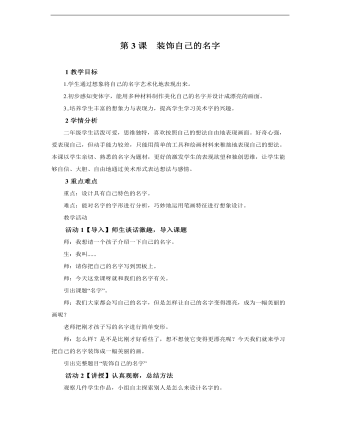
小学美术人教版二年级上册《第3课装饰自己的名字》教学设计说课稿
2学情分析二年级学生活泼可爱,思维独特,喜欢按照自己的想法自由地表现画面。好奇心强,爱表现自己,但动手能力较差,只能用简单的工具和绘画材料来稚拙地表现自己的想法。本课以学生亲切、熟悉的名字为题材,更好的激发学生的表现欲望和独创思维,让学生能够自信、大胆、自由地通过美术形式表达想法与感情。3重点难点重点:设计具有自己特色的名字。难点:能对名字的字形进行分析,巧妙地运用笔画特征进行想象设计。教学活动

小学美术人教版三年级上册《第1课魔幻的颜色》教学设计说课稿
2学情分析1、学生学习美术的态度:很多学生上美术课时会抱着“玩”的心理,针对学生的这种思想,我们应当根据学生的年龄特点,在备课过程中注意挖掘教材中有趣的内容,寻找学生的兴趣点,充分地让美术教学体现出身心愉悦的活动特点,寓教于乐,防止把美术课变成一种枯燥的令人生厌的劳动。2、学生认知发展分析:在美术课堂上常常听到这样的声音:“我画(做)不好”、“我不会画(做)”;这就需要美术教师在课堂教学中注重引导学生感受、观察、体会、表现,让学生在一系列“玩中学”的活动过程中慢慢树立信心。所以围绕本课教学目的和任务,我采用情境教学法、观察对比法、直观演示法三种教学方式;学生运用四种方法进行学习:观察法、讨论法、实践体验法、合作交流法;努力营造一个开放和谐的课堂氛围,顺利完成教学目标。
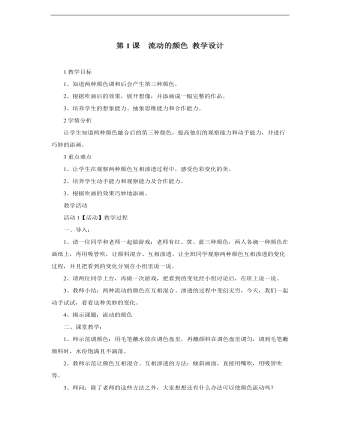
小学美术人教版二年级上册《第1课流动的颜色》教学设计说课稿
一、导入:1、请一位同学和老师一起做游戏:老师有红、黄、蓝三种颜色,两人各滴一种颜色在画纸上,再用吸管吹,让颜料混合、互相渗透。让全班同学观察两种颜色互相渗透的变化过程,并且把看到的变化分别在小组里说一说。2、请两位同学上台,再做一次游戏,把看到的变化经小组讨论后,在班上说一说。3、教师小结:两种流动的颜色在互相混合、渗透的过程中变幻无穷,今天,我们一起动手试试,看看这种美妙的变化。4、揭示课题:流动的颜色
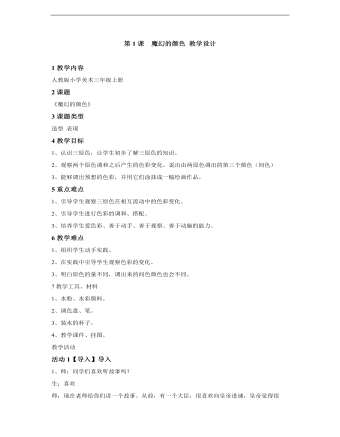
小学美术人教版三年级上册《第1课魔幻的颜色》教学设计模板说课稿
3课题类型造型表现4教学目标1、认识三原色,让学生初步了解三原色的知识。2、观察两个原色调和之后产生的色彩变化,说出由两原色调出的第三个颜色(间色)3、能够调出预想的色彩,并用它们涂抹成一幅绘画作品。5重点难点1、引导学生观察三原色在相互流动中的色彩变化。2、引导学生进行色彩的调和、搭配。3、培养学生爱色彩、善于动手、善于观察、善于动脑的能力。
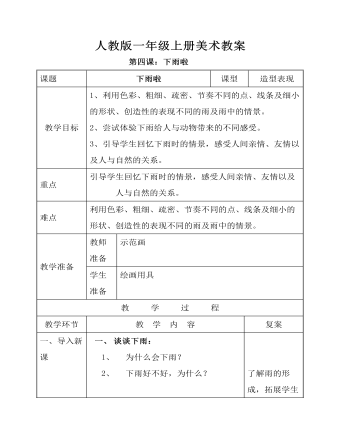
小学美术人教版一年级上册《第4课下雨啦》教案说课稿
1、利用色彩、粗细、疏密、节奏不同的点、线条及细小的形状、创造性的表现不同的雨及雨中的情景。2、尝试体验下雨给人与动物带来的不同感受。3、引导学生回忆下雨时的情景,感受人间亲情、友情以及人与自然的关系。
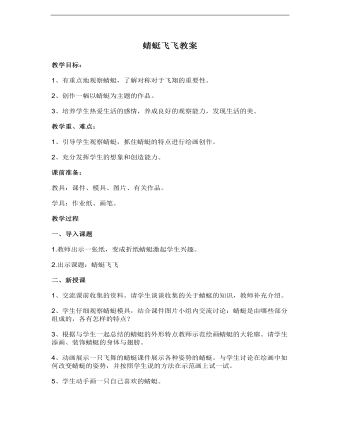
小学美术人教版二年级上册《第9课蜻蜓飞飞》教案说课稿
1、引导学生观察蜻蜓,抓住蜻蜓的特点进行绘画创作。2、充分发挥学生的想象和创造能力。课前准备:教具:课件、模具、图片、有关作品。学具:作业纸、画笔。教学过程一、导入课题1.教师出示一张纸,变成折纸蜻蜓激起学生兴趣。2.出示课题:蜻蜓飞飞二、新授课1、交流课前收集的资料。请学生谈谈收集的关于蜻蜓的知识,教师补充介绍。2、学生仔细观察蜻蜓模具,结合课件图片小组内交流讨论:蜻蜓是由哪些部分组成的,各有怎样的特点?
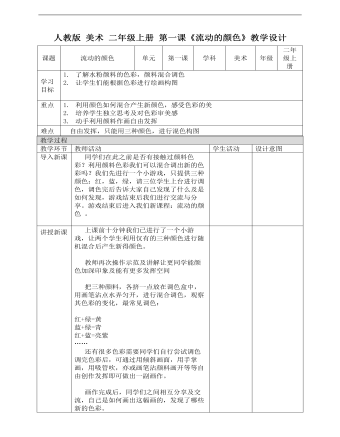
小学美术人教版二年级上册《第1课流动的颜色》教案说课稿
同学们在此之前是否有接触过颜料色彩?利用颜料色彩我们可以混合调出新的色彩吗?我们先进行一个小游戏,只提供三种颜色:红,蓝,绿,请三位学生上台进行调色,调色完后告诉大家自己发现了什么及是如何发现,游戏结束后我们进行交流与分享。游戏结束后进入我们新课程:流动的颜色 。

小学美术人教版一年级上册《第20课美丽的植物和动物》教案说课稿
2、懂得要爱护动植物,对破坏植物、残杀动物的行为表示气愤,在日常生活中能自觉做到爱护动植物,不做破坏动植物生态环境的事,积极参加保护动植物的公益活动。活动重点:感受动植物的生命现象,懂得爱护动植物。
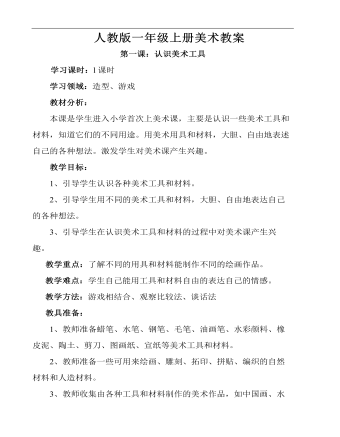
小学美术人教版一年级上册《第1课认识美术工具》教案说课稿
1、引导学生认识各种美术工具和材料。2、引导学生用不同的美术工具和材料,大胆、自由地表达自己的各种想法。3、引导学生在认识美术工具和材料的过程中对美术课产生兴趣。教学重点:了解不同的用具和材料能制作不同的绘画作品。教学难点:学生自己能用工具和材料自由的表达自己的情感。教学方法:游戏相结合、观察比较法、谈话法
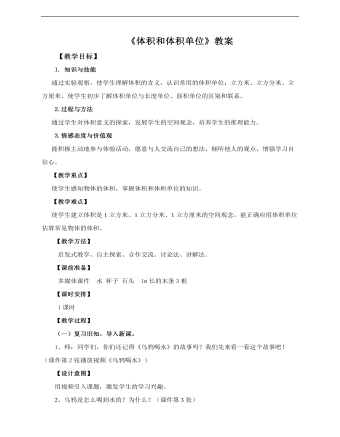
小学数学人教版五年级下册《第四课体积和体积单位》教案说课稿
(一)复习旧知,导入新课。1、师:同学们,你们还记得《乌鸦喝水》的故事吗?我们先来看一看这个故事吧!(课件第2张播放视频《乌鸦喝水》)【设计意图】用视频引入课题,激发学生的学习兴趣。2、乌鸦是怎么喝到水的?为什么?(课件第3张)生1:乌鸦把石子投进水罐中,水面升高了,乌鸦就喝到水了。生2:这说明石子占了一定的空间,所以水面会升高,乌鸦才能喝到水。师:这节课我们就来研究一下体积和体积单位。(板书课题)(二)探究新知1.小组实验并观察:(课件地4张)(1)取两个同样大小的玻璃杯,先往一个杯子里倒满水;取一块鹅卵石放入另一个杯子,再把第一个杯子里的水倒进第二个杯子里,会出现什么情况?为什么?(2)汇报交流:(课件第5张)生1:第一个杯子里的水不能全部倒入第二个杯子里。师:你知道为什么会出现这种现象吗?生2:鹅卵石占了一定的空间,所以第一个杯子会剩下一部分水。【设计意图】用实验的方式,让学生从实验的过程中发现现象并进一步思考原因,从而找到规律,培养学生的观察能力、思维能力。2.下面的洗衣机、影碟机和手机,哪个所占的空间大?(课件第6张)洗衣机所占的空间最大。3.引入体积的意义:师:物体所占空间的大小叫做物体的体积。师:上面三个物体,哪个体积最大?哪个体积最小? 生:洗衣机的体积最大,手机的体积最小。4.学习体积单位(课件第7张)(1)怎样比较下面两个长方体体积的大小呢?
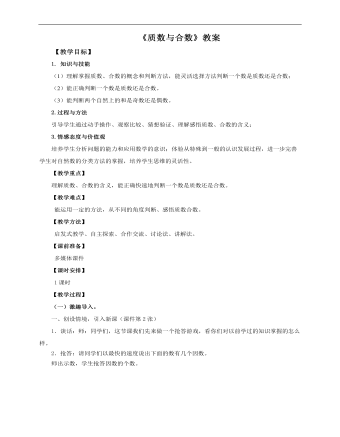
小学数学人教版五年级下册《第四课质数和合数》教案说课稿
(一)激趣导入。 一、创设情境,引入新课(课件第2张)1.谈话:师:同学们,这节课我们先来做一个抢答游戏,看你们对以前学过的知识掌握的怎么样。2.抢答:请同学们以最快的速度说出下面的数有几个因数。师出示数,学生抢答因数的个数。3.思考:(1)一个数的最小因数是几?最大因数是几?(课件第3张)(2)一个数的因数是有限的还是无限的?(3)怎样找一个数的因数?生1:一个数是最小因数是1,最大因数是它本身。 生2:一个数因数的个数是有限的。生3:找一个数的因数,用这个数依次除以1,2,3,4……商如果是整数,除数和商都是这个数的因数。 【设计意图】用抢答游戏的方式引入课题,引起学生的兴趣,通过对旧知识的复习,为下面要学习的质数与合数做准备。4.师:我们学过找一个数的因数的方法,那一个数的因数的个数又有什么规律呢?这节课我们来学习两个新概念:质数和合数。(板书课题) . (二)探究新知 1. 找出1—20各数的因数,看看它们的因数的个数有什么规律。(1)学生小组内交流,写出1——20各数的因数,看看它们的因数的个数有什么特点。(课件第4张演示)1的因数有:1 11的因数有:1,11 2的因数有:1,2 12的因数有:1,2,3,4,6,12 3的因数有:1,3 13的因数有:1,13 4的因数有:1,2,4 14的因数有:1,2,7,14 5的因数有:1,5 15的因数有:1,3,5,15 6的因数有:1,2,3,6 16的因数有:1,2,4,8,16 7的因数有:1,7 17的因数有:1,17 8的因数有:1,2,4,8 18的因数有:1,2,3,6,9,18 9的因数有:1,3,9 19的因数有:1,19 10的因数有:1,2,5,10 20的因数有:1,2,4,5,10,20

